Orchid News – July 2010
Home > Orchid News > 2010
Index
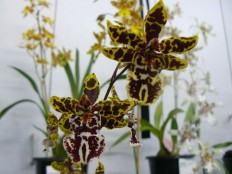
Calendar
- 1 July Ed Pearce on Computers and Orchids
- 5 Aug Ron Alexander on Australian natives
- 2 Sept Bernie Hoffman on pollinating orchids
- 8-11 Sept Coffs Harbour Orchid Society Spring Show
July Meeting
The guest speaker for our July meeting will be Ed Pearce. He will be talking about the use of computers to learn about orchids.
Brochure
We have developed a brochure for new members which explains things about the orchid society such as the monthly competition, raffles, etc.
The brochure is for new members, but we will give everyone a copy and ask for suggestions about what could be included.
Orchidwiz Raffle
Congratulations to Don Turner on winning the raffle for the Orchidwiz program. Don has generously allowed us to load the program onto Ed’s laptop computer so that it can be available to society members.
Growing Dendrobium Kingianum
I grow them in a mixture of 50%medium bark, 40% of 12-18 size coco-chip & 10% of white river gravel. I prefer gravel but lately I’ve been using Maidenwell stone “The Choice is Yours!”
If plants are just out of flasks or in tubes I use small bark and small white gravel or Maidenwell stone. When potting up to 70 mil. pots I still use the same mix. But when I go up to 100mil. Pots or over I use medium bark and gravel. Sometimes I use Medium Bark, 12-18 coco-chip and Maidenwell stone. I always use Port squat Pots. When re-potting, don’t overpot. Kingis like to be a bit cramped.
I fertilize weekly, weakly with Seasol & Powerfeed. During hot or windy days I may water lightly at 4 to 5 days.
A couple of times a year I water with Condy’s Crystals (KMnO4) – make sure the mixture is only pale pink.
Two spotted mites love dendrobiums, so at the first sign of mites I use Hortico Red Spider at the recommended rate. But from next spring I’m going to start using Eco Oil, it’s safer. You can’t be too careful. (5mil. of Oil to 1 litre of water.
GOOD GROWING – Norm Mitchell.
Gift Vouchers
The society has several gift vouchers from Easy Orchids in Woodburn. If anyone is going to buy items from Easy Orchids see Treasurer Bruce Hall and he will sell you vouchers which you can use to purchase orchids, pots, etc.
This way the society benefits and there is no disadvantage for the member who uses the vouchers.
Offer of Bulbophyllums
The society has been contacted by Eric Beltrame who has a large number of Bulbophyllums that he wants to sell or swap. If you are interested you can contact him directly at eric.beltrame@westnet.com.au or call him on 07 4777 4965.
Or you can contact the secretary who has a list of the 100 plants he has for sale or swapping.
Newsletter Editor
Sherrill Harrison, one of our new members, has volunteered to be newsletter editor while Ed is away for surgery later in the year. Thanks to Sherrill for her offer
Growing Sarcochilus
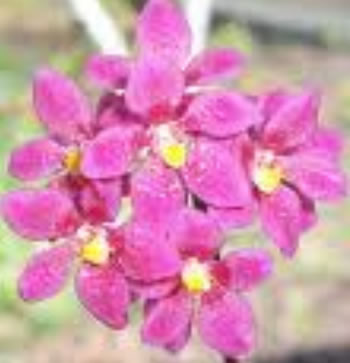
Sarcochilus hybrid
These readily available orchids are easy to grow and, once mature, flower regularly each year. A judicious choice of species and hybrids can extend the flowering period from spring to midsummer.
Sarcochilus hartmannii is one of the most popular species in cultivation. Its range extends from central New South Wales to Queensland, where it is usually found growing at medium altitudes in lightly shaded areas. It is therefore well adapted to shade house cultivation in Melbourne. Like many other sarcochilus species, it grows amongst leaf litter in a variety of locations, or as a lithophyte on rocks. Although it can be grown on a slab of wood or tree fern, I prefer pot culture, using a mix of pine bark and small pebbles to ensure good drainage. Sarcochilus hartmannii tolerates higher light levels than some species and grows and flowers well under 50% shadecloth. Plants hung high in the shade house during winter benefit from the slightly warmer and brighter conditions. The better forms of S. hartmannii, especially those originally collected from Blue Nob in the Nightcap Ranges, south of Murwillimbah in northern NSW, produce glistening white, shapely flowers on a semi-upright inflorescence.
Sarcochilus aequalis, known as the southern form of S. hartmannii before it was recently accorded separate species status, flowers in early spring and produces smaller, cream-coloured flowers on crowded, pendulous spikes. It grows well in Melbourne and eventually develops into a spectacular specimen plant.
Sarcochilus fitzgeraldii, sometimes called the ‘ravine orchid’, has white or cream flowers with a central red blotch or spots. It flowers in the spring and grows well in Melbourne. As its common name suggests, it is found in ravines and moist gullies, enjoying much more shade than S. hartmannii. Its main requirement is a cool, airy spot with 70-80% shade and plenty of water during its active growing period. Most growers choose a wide, shallow pot to accomodate its extensive root system and use a coarse mixture of bark chunks and pieces of sandstone or river pebbles as potting mix. S. fitzgeraldii tends to grow in a creeping fashion, its leaves flattened and curved inwards, rather than following the more upright growth habit of S. hartmannii. While there are many attractive cultivars, the eye-catching flowers of S. fitzgeraldii ’50 cents’ are noteworthy for their large size and deep red centre.
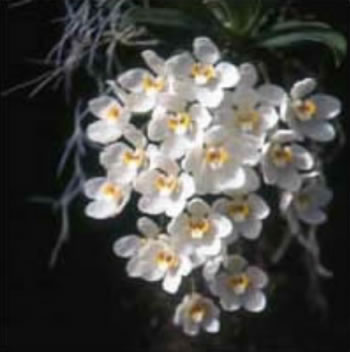
Sarcochilus falactus ‘Jacki’ AM/OSCOV
Sarcochilus falcatus is another cool-growing species suited to a variety of climates, although some growers find it is a difficult species to grow well. Commonly known as ‘the orange blossom orchid’, its white sepals and petals and yellow-margined labellum make Sarcochilus falcatus a most attractive orchid. Its range extends from eastern Victoria to Queensland, the flowers differing in size, petal shape and lip markings at various locations, although their overall colour remains constant. S. falcatus grows well when mounted on a weathered slab, tree branch, tree fern or natural cork. Small terracotta pots with an open mix have also proved to be successful in starting a plant in cultivation.
Sarcochilus ceciliae grows on rocky outcrops in the mountains of northern Queensland. It has beautiful pink flowers carried on upright inflorescences, however the growth tends to be sparse and straggly, and its narrow leaves give the impression that the plant is ‘on its last legs’. This is generally not the case, as it is a tenacious orchid, well adapted to surviving long dry spells. Shallow pots should be used, as S. ceciliae is basically surface-rooting. A potting mix of small rocks (scoria, sandstone, limestone) and larger bark chunks is suitable. It is essential that the roots not be covered by the potting mix when transplanting; simply place the plant on top of the potting mix and secure it with fishing line or wire pegs. Some S. ceciliae hybrids, such as S. Lois, also seem to grow better if potted in this way.
While there are several other sarcochilus species, most are poor growers outside their natural habitat. You will occasionally see the lovely green flowers of Sarcochilus olivaceous or the small pink flowers of S. hillii on the show bench, but many of the others, such as S. australis, native of the Otways and wet bushland areas of Gippsland, are difficult to cultivate. Some growers have kept these species going on their natural bush mounts and have used them in hybridising.
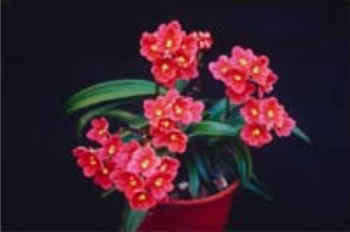
Sarcochilus Yvette ‘Jakes Pride’ HCC/OSCOV
Sarcochilus Hybrids. One of the first hybrids, produced in 1963, was S. Fitzhart, bred from S. hartmannii and S. fitzgeraldii. Its flowers are usually white to pink with solid or spotted centres, and held on upright inflorescences. Over recent years, as better ‘line-bred’ cultivars of S. hartmannii and S. fitzgeraldii have become available, S. Fitzhart has been re-made many times, with consequent improvement in flower shape, colour and size. Other common hybrids include S Heidi (S. Fitzhart x S. hartmannii), S. Melba (S. hartmannii x S. falcatus), S. Lois (S. hartmannii x S. ceciliae), S. Mavis (S. ceciliae x S. fitzgeraldii), S. Pinky (S. Mavis x S. hartmannii) and S. Bongeen (S. Mavis x S. fitzgeraldii), to name a few.
Recent hybrids include S. Rosalie, S. Powder Puff, S. Colonial Rose, S. Penny Ann, S. First Light, S. Otways, S. Pink Blossom, S. Selina, S. Lone Star, S. Peach Spot, S. Sun Spot, S. Jewell, S. Wandjina and S. James Woolf. You should look out for these more recent hybrids as most have superior colour, shape or character.
(Thanks to The Orchid Societies Council of Victoria for this article)
Agenda for July 2010 Meeting
- Welcome, Apologies, Visitors.
- New members
- Minutes of June meeting
- Business Arising
- Have contacted David Banks to be guest speaker next year.
- Will adopt the proposed changes to Oncidiinae section for Show s for a trial period
- Thanks to Sherrill Harrison for volunteering to do the newsletter when Ed is away.
- Committee Report
- Inwards Correspondence
- BCU Statements.
- Friends of Botanic Gardens newsletter
- 2AirFM newsletter
- Orchids Australia magazine
- Thanks from Glad.
- Outwards Correspondence
- Thanks to Dennis Sinclair.
- Finance Report
- Sponsors Spot
- General Business
- Guest Speaker: Ed Pearce will be talking about the use of computers to learn about orchids.
- Raffle, popular vote, table talk.
Minutes for June 2010 Meeting
- President Don welcomed the 31 people present – a very good attendance given the poor weather – and gave a special welcome to our guest speaker Dennis Sinclair and his wife Noelene.
- Apologies were received from Gordon Clarke, Leonie Strauss, Brian Moore, Joy Kelly, Di Blay, Ken and Dulcie, Pauline George, Inge and Herb Zegelin, Steve Clemesha.
- Minutes of May meeting – Mvd Betty, Scd Barb That minutes be approved
- Business Arising – in general business.
- Committee Report – Ed referred to report in newsletter. Items raised under general business.
- Inwards Correspondence
- BCU Statements
- Bellingen Show – 21 August
- St Ives Orchid Fair – 13/15 August
- Tinonee Catalogue
- Easy Orchids – supplies catalogue
- Cymbidium Club of Australia – Extravaganza Aug
- Outwards Correspondence
- Thanks to Murray Shergold.
- Get well to Glad, Graeme
- Thanks to Ivy.
Mvd Kay, Scd Betty That inwards correspondence be received and outwards correspondence be approved
- Finance Report
- Sponsors Spot – Ed spoke about Victor Rullis Funeral Services and encouraged members to keep him in mind if you need the services of a funeral director.
- GENERAL BUSINESS
- Review of Autumn Show. Members were invited to comment on the Autumn Show. People basically happy with how it went. Special thanks to our Show Marshall Ivy. Agreed to include a seedling flowering first time section, and to consider re-arranging the Oncidium and Odontoglossum sections into “starry Brassia influenced orchids” , and “rounder Odontoglossum influenced orchids”.
- 40th birthday proposal – Members supported the notion of a luncheon with a good guest speaker and an orchid display. Ed to contact David Banks to decide on a date.
- During Ed’s absence later in the year, Steve Clemesha will carry out secretary duties, Sue Williams will do typing. A volunteer was sought to do the newsletter.
- Agreed that we should consider re-organising Oncidium and Odontoglossum Alliances as described above for monthly competition for 2010.
- Guest speaker. Dennis Sinclair from Port Macquarie spoke about the breeding of and growing Sarcochilus orchids. Dennis showed photos showing the basic species, and the breeding that has been done to get the range of colours, shapes, textures and spotted flowers available today.
- Popular vote was won by Norm and Kay’s Paphiopedilum. Ed did a brief table talk.
- The raffles were won by Don, Peter and Gary.
- Don won the Orchidwiz Raffle.
- The meeting closed at 9.20 for supper and a social time.
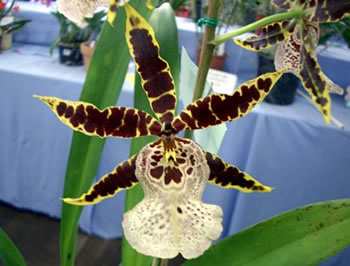
Degarmoara Flying High
Committee Report
Committee met at Ed’s on 9th June. Matters discussed were
- Autumn Show – agreed with proposed changes to schedule.
- Sherrill has volunteered to do the newsletter when Ed is away.
- Agreed that we will use same arrangements for 2010 AGM as for 2009, i.e. nominations to be done before the meeting..
- Will re-organise the library.
- Will finalise and distribute the new members brochure.